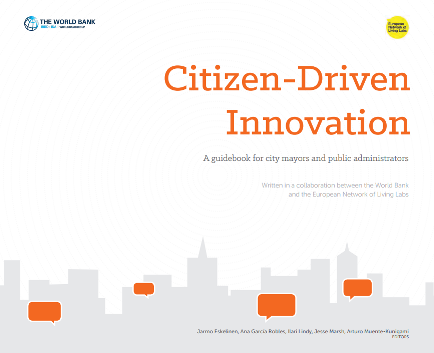This new report from the World Bank aims to bring citizen-driven innovation to policy makers and change agents around the globe, by spreading good practice on open and participatory approaches as applied to digital service development in different nations, climates, cultures, and urban settings.
The report explores the concept of smart cities through a lens that promotes citizens as the driving force of urban innovation. Different models of smart cities are presented, showing how citizen-centric methods have been used to mobilize resources to respond to urban innovation challenges in a variety of situations, objectives, and governance structures. The living lab approach strengthens these processes as one of the leading methods for agile development or the rapid prototyping of ideas, concepts, products, services, and processes in a highly decentralized and user-centric manner.
By adopting these approaches and promoting citizen-driven innovation, cities around the world are aiming to alleviate the demand for services, increase the quality of delivery, and promote local entrepreneurship. This guidebook is structured into seven main sections: an introductory section describes the vision of a humanly smart city, in order to give an idea of the kind of result that can be attained from opening up and applying citizen-driven innovation methods.
- Chapter One: Getting started helps mayors launch co-design initiatives, exploring innovation processes founded on trust and verifying the benefits of opening up.
- Chapter Two: Building a strategy identifies the key steps for building an innovation partnership and together defining a sustainable city vision and scenarios for getting there.
- Chapter Three: Co-designing solutions looks at the process of unpacking concrete problems, working creatively to address them, and following up on implementation.
- Chapter Four: Ensuring sustainability describes key elements for long-term viability: evaluation and impact assessment, appropriate institutional structuring, and funding and policy support.
- Chapter Five: Joining forces suggests ways to identify a unique role for participation in international networks and how to best learn from cooperation.
Finally, the report provides a starter pack with some of the more commonly used tools and methods to support the kinds of activities described in this guidebook.

